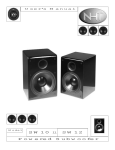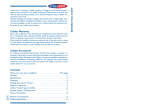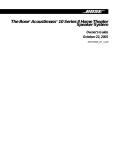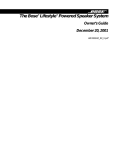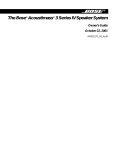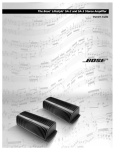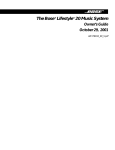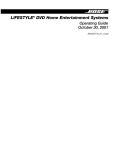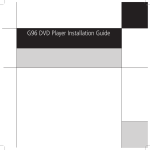Download Bose Lifestyle 3 Operating instructions
Transcript
The Bose® Lifestyle® Amplifier Owner’s Guide January 4, 2002 AM262840_00_V.pdf Safety Information WARNING: To reduce the risk of fire or electric shock, do not expose the system to rain or moisture. CAUTION AV VI S S RISK OF ELECTRICAL SHOCK DO NOT OPEN RISQUE DE CHOC ÉLECTRIQUE NE PAS OUVRIR CAUTION: TO REDUCE THE RISK OF ELECTRIC SHOCK, DO NOT REMOVE COVER (OR BACK). NO USER-SERVICABLE PARTS INSIDE. REFER SERVICING TO QUALIFIED PERSONNEL. ATTENTION : POUR RÉDUIRE LE RISQUE DE DÉCHARGE ÉLECTRIQUE, NE PAS RETIRER LE COUVERCLE (OU L’ARRIÈRE). IL NE SE TROUVE À L’INTÉRIEUR AUCUNE PIÈCE POUVANT ÊTRE RÉPARÉE PAR L’USAGER. S’ADRESSER À UN RÉPARATEUR COMPÉTENT These CAUTION marks are located on the bottom panel of your Lifestyle® stereo amplifier: The lightning flash with arrowhead symbol, within an equilateral triangle, is intended to alert the user to the presence of uninsulated dangerous voltage within the system enclosure that may be of sufficient magnitude to constitute a risk of electric shock. The exclamation point within an equilateral triangle, as marked on the system, is intended to alert the user to the presence of important operating and maintenance instructions in this owner’s guide. CAUTION: To prevent electric shock, match wide blade of plug to wide slot, insert fully. Additional safety information See the additional instructions on the Important Safety Information page enclosed with this owner’s guide. Please read this owner’s guide Please take the time to follow this owner’s guide carefully. It will help you set up and operate your Lifestyle® stereo amplifier properly. Save your owner’s guide for future reference. ©2001 Bose Corporation. All rights reserved. Bose, Acoustimass, Lifestyle, Personal and Wave are registered trademarks of Bose Corporation. 2 January 4, 2002 AM262840_00_V.pdf Important Safety Instructions 1. Read these instructions – for all components before using this product. 11. Only use attachments/accessories specified by the manufacturer. 2. Keep these instructions – for future reference. 3. Heed all warnings – on the product and in the owner’s guide. 4. Follow all instructions. 5. Do not use this apparatus near water or moisture – Do not use this product near a bathtub, washbowl, kitchen sink, laundry tub, in a wet basement, near a swimming pool, or anywhere else that water or moisture are present. 12. Use only with the cart, stand, tripod, bracket or table specified by the manufacturer or sold with the apparatus. When a cart is used, use caution when moving the cart/apparatus combination to avoid injury from tip-over. 6. Clean only with a dry cloth – and as directed by Bose® Corporation. Unplug this product from the wall outlet before cleaning. 7. Do not block any ventilation openings. Install in accordance with the manufacturer’s instructions – To ensure reliable operation of the product and to protect it from overheating, put the product in a position and location that will not interfere with its proper ventilation. For example, do not place the product on a bed, sofa, or similar surface that may block the ventilation openings. Do not put it in a built-in system, such as a bookcase or a cabinet that may keep air from flowing through its ventilation openings. 13. Unplug this apparatus during lightning storms or when unused for long periods of time – to prevent damage to this product. 14. Refer all servicing to qualified service personnel. Servicing is required when the apparatus has been damaged in any way: such as power-supply cord or plug is damaged; liquid has been spilled or objects have fallen into the apparatus; the apparatus has been exposed to rain or moisture, does not operate normally, or has been dropped – Do not attempt to service this product yourself. Opening or removing covers may expose you to dangerous voltages or other hazards. Please call Bose to be referred to an authorized service center near you. 15. To prevent risk of fire or electric shock, avoid overloading wall outlets, extension cords, or integral convenience receptacles. 8. Do not install near any heat sources, such as radiators, heat registers, stoves or other apparatus (including amplifiers) that produce heat. 16. Do not let objects or liquids enter the product – as they may touch dangerous voltage points or short-out parts that could result in a fire or electric shock. 9. Do not defeat the safety purpose of the polarized or grounding-type plug. A polarized plug has two blades with one wider than the other. A groundingtype plug has two blades and a third grounding prong. The wider blade or third prong are provided for your safety. If the provided plug does not fit in your outlet, consult an electrician for replacement of the obsolete outlet. 17. See product enclosure bottom for safety related markings. 10. Protect the power cord from being walked on or pinched, particularly at plugs, convenience receptacles, and the point where they exit from the apparatus. AM262840_00_V.pdf 18. Use Proper Power Sources – Plug the product into a proper power source, as described in the operating instructions or as marked on the product. 19. Avoid Power Lines – Use extreme care when installing an outside antenna system to keep from touching power lines or circuits, as contact with them may be fatal. Do not install external antennas near overhead power lines or other electric light or power circuits, nor where an antenna can fall into such circuits or power lines. January 10, 2002 2a Important Safety Instructions 20. Ground All Outdoor Antennas – If an external antenna or cable system is connected to this product, be sure the antenna or cable system is grounded. This will provide some protection against voltage surges and built-up static charges. Note: Unauthorized modification of the receiver or radio remote control could void the user’s authority to operate this equipment. Section 810 of the National Electrical Code ANSI/NFPA No. 70 provides informaiton with respect to proper grounding of the mast and supporting structure, grounding of the lead-in wire to an antenna discharge unit, size of grounding conductors, location of antenna-discharge unit, connection to grounding electrodes, and requirements for the ground electrode. Refer to the antenna grounding illustration on this page. Antenna grounding This product complies with the Canadian ICES-003 Class B specifications. Example of antenna grounding as per National Electrical Code, ANSI/NFPA 70. Antenna lead-in wire Information about products that generate electrical noise If applicable, this equipment has been tested and found to comply with the limits for a Class B digital device, pursuant to Part 15 of the FCC rules. These limits are designed to provide reasonable protection against harmful interference in a residential installation. This equipment generates, uses, and can radiate radio frequency energy and, if not installed and used in accordance with the instructions, may cause harmful interference to radio communications. However, this is no guarantee that interference will not occur in a particular installation. If this equipment does cause harmful interference to radio or television reception, which can be determined by turning the equipment off and on, you are encouraged to try to correct the interference by one or more of the following measures: • Reorient or relocate the receiving antenna. • Increase the separation between the equipment and receiver. Ground clamp Antenna discharge unit (NEC Section 810-20) Grounding conductors (NEC Section 810-21) Electric service equipment Ground clamps Power service grounding electrode system (NEC ART 250, Part H) Note to CATV system installer This reminder is provided to call the CATV system installer’s attention to Article 820-40 of the NEC (of USA) that provides guidelines for proper grounding. In particular, it specifies that the cable ground shall be connected to the grounding system of the building, as close to the point of cable entry as is practical. • Connect the equipment to an outlet on a different circuit than the one to which the receiver is connected. • Consult the dealer or an experienced radio/TV technician for help. ©2001 Bose Corporation, The Mountain, Framingham, MA 01701-9168 USA 255805 AM Rev.00 JN10494 2b January 10, 2002 AM262840_00_V.pdf Contents Setting up your Lifestyle® Stereo Amplifier Before you begin . . . . . . . . . . . . . . . . . . . . . . . . . . . . . . . . . . . . . . . . . . . . . . . . . . . . . . . . Unpacking the carton . . . . . . . . . . . . . . . . . . . . . . . . . . . . . . . . . . . . . . . . . . . . . . . . . . . . . Selecting a location for your Lifestyle® stereo amplifier . . . . . . . . . . . . . . . . . . . . . . . . . . . Connecting the Lifestyle® stereo amplifier to a multi-room interface . . . . . . . . . . . . . . . . . Connecting the Lifestyle® stereo amplifier to a Lifestyle® media center . . . . . . . . . . . . . . . Setting up the remote control . . . . . . . . . . . . . . . . . . . . . . . . . . . . . . . . . . . . . . . . . . . Setting Zone 2 Protocol . . . . . . . . . . . . . . . . . . . . . . . . . . . . . . . . . . . . . . . . . . . . . . . . Connecting the Lifestyle® stereo amplifier to a Model 20 music center . . . . . . . . . . . . . . . Connecting the Lifestyle® stereo amplifier to a Model 5 music center . . . . . . . . . . . . . . . . Connecting speakers to your Lifestyle® stereo amplifier . . . . . . . . . . . . . . . . . . . . . . . . . . Checking to see if you have a dual voltage Lifestyle® amplifier . . . . . . . . . . . . . . . . . . . . . Powering-up your system . . . . . . . . . . . . . . . . . . . . . . . . . . . . . . . . . . . . . . . . . . . . . . . . . . 4 4 5 7 9 10 10 11 13 14 15 15 Maintaining Your Lifestyle® Stereo Amplifier Cleaning the amplifier . . . . . . . . . . . . . . . . . . . . . . . . . . . . . . . . . . . . . . . . . . . . . . . . . . . . . Protecting outdoor wiring . . . . . . . . . . . . . . . . . . . . . . . . . . . . . . . . . . . . . . . . . . . . . . . . . . Troubleshooting . . . . . . . . . . . . . . . . . . . . . . . . . . . . . . . . . . . . . . . . . . . . . . . . . . . . . . . . . Customer service . . . . . . . . . . . . . . . . . . . . . . . . . . . . . . . . . . . . . . . . . . . . . . . . . . . . . . . . Warranty period . . . . . . . . . . . . . . . . . . . . . . . . . . . . . . . . . . . . . . . . . . . . . . . . . . . . . . . . . Technical information . . . . . . . . . . . . . . . . . . . . . . . . . . . . . . . . . . . . . . . . . . . . . . . . . . . . . 16 16 16 17 17 18 For your records The serial number is located on the bottom panel of your Lifestyle® stereo amplifier. Serial number: ____________________________ Purchase date: ______________________________________ We suggest you keep your sales receipt and warranty card together with this owner’s guide. AM262840_00_V.pdf January 4, 2002 3 Setting up your Lifestyle® Stereo Amplifier Before you begin Thank you for purchasing the Lifestyle® stereo amplifier. The Lifestyle® stereo amplifier provides you with a simple solution when you want to add Bose® non-powered environmental speakers or Bose non-powered accessory speakers to your Lifestyle® system. Bose proprietary Integrated Signal Processing technology, featured in the amplifier, ensures full, rich stereo sound, even when the speakers are playing at low volumes. By using the Lifestyle® stereo amplifier to expand your system, you can enjoy Bose quality sound and Lifestyle® system convenience in your yard, patio, swimming deck, garage, or utility room. Unpacking the carton WARNING: To avoid danger of suffocation, keep the plastic bags out of the reach of children. Carefully unpack the shipping carton. Make sure the shipping carton for your Lifestyle® stereo amplifier includes the parts identified in Figure 1. We recommend saving all packing materials. You may need them later. The original packing materials provide the safest way to transport this product. Note: Locate the serial number on the bottom panel of the amplifier, and write it in the appropriate blank on page 3. If any part of the product appears to be damaged, do not attempt to use it. Contact your authorized Bose dealer immediately, or call Bose Customer Service. Refer to the address list enclosed in the product packaging for correct phone numbers. Figure 1 Contents of the shipping carton 30-ft audio input cable PN197406 Lifestyle® stereo amplifier Owner’s guide Power cord* USA/Canada (120V) * The Lifestyle® stereo amplifier includes a 120V AC (mains) power cord for use in the USA and Canada, or the appropriate 230V or 240V power cord for international use. Dual voltage units include a 120V power cord and a 230V plug adapter. See “Checking to see if you have a dual voltage Lifestyle® amplifier” on page 15 for instructions on setting the dual-voltage selection switch. 230V Europe (230V) plug adaptor UK/Singapore (230V) Australia (240V) Note: Use only the power cord supplied with your Lifestyle® stereo amplifier. If the power cord does not fit your power (mains) outlet, DO NOT alter the plug in any way. Contact Bose Customer Service for assistance. Note: The Lifestyle® stereo amplifier is designed for use with Bose non-powered environmental speakers or Bose non-powered accessory speakers ONLY. CAUTION: If you purchased a dual voltage unit, DO NOT plug it into an AC (mains) outlet until you check the position of the voltage selection switch on the rear panel of the product. Using the wrong voltage setting may cause damage to your product. See “Checking to see if you have a dual voltage Lifestyle® amplifier” on page 15. 4 January 4, 2002 AM262840_00_V.pdf Setting Up Your Lifestyle® Stereo Amplifier Selecting a location for your Lifestyle® stereo amplifier Select a location for your Lifestyle® stereo amplifier and mount it according to the following guidelines. CAUTION: DO NOT mount the amplifier on surfaces that are not sturdy enough, or that have hazards concealed behind them, such as electrical wiring or plumbing. The amplifier must be placed indoors. It is neither designed nor tested for use outdoors or on boats. Although the amplifier does not need to be situated close to either your Lifestyle® system or the accessory speakers, consider the following guidelines when selecting a location for your amplifier: • Locate the amplifier indoors and within 8 feet (2.5 m) of a power outlet. • Make sure that the amplifier is located within the reach of the supplied 30-foot audio input cable. • Place the amplifier in an area where the maximum ambient temperature is less than 104°F (45°C). • For optimum performance, place the amplifier in a well-ventilated area. • DO NOT PLACE THE AMPLIFIER IN A COMPLETELY ENCLOSED AREA – If the amplifier is installed on a shelf, or in a bookcase, or inside an entertainment center, maintain 2.0 inches (5.0 cm) minimum clearance (Figure 2) on all sides of the amplifier with an open area of 3.0 inches (7.5 cm) minimum immediately above it to allow for air flow. If adequate ventilation is not provided, the amplifier will automatically protect itself by reducing its volume level in order to limit its temperature. • DO NOT place the amplifier on any heat-sensitive surface, such as the finished surface of fine furniture. Like all electrical equipment, it generates some heat. • DO NOT use the amplifier in a damp location. It is important to prevent moisture from getting into the unit. Figure 2 Required clearance between the amplifier and any material or surface. 3.0 in. (7.5 cm) 2.0 in. (5.0 cm) 2.0 in. (5.0 cm) 2.0 in. (5.0 cm) 2.0 in. (5.0 cm) • When mounting the amplifier on a horizontal surface like a floor or shelf (Figure 3), the amplifier’s rubber feet provide stability and prevent scratches. Figure 3 Horizontal surface mounting • To mount the amplifier on a wall (Figure 4), remove the rubber feet and use the existing guide holes in the amplifier’s enclosure. See Figure 5 on page 6 for recommended mounting hardware. Figure 4 Wall mounting AM262840_00_V.pdf January 4, 2002 5 Setting Up Your Lifestyle® Stereo Amplifier Figure 5 Recommended mounting hardware To mark hole locations, first remove the rubber feet. Then, hold the amplifier in place and mark the wall through the clearance holes in the amplifier enclosure. You will need: 3 /32 in. (2.25 mm) Wood wall (4) #10 x 11/2 in. (M5 x 36 mm) 1 /2 in. (12 mm) Wallboard (4) #10 x 21/2 in. (M5 x 75 mm) (4) #10 (M5) 1 /4 in. (6 mm) Masonry wall (4) #10 x 11/2 in. (M5 x 36 mm) (4) #10 x 1 in. (M5 x 25 mm) 6 January 4, 2002 AM262840_00_V.pdf Setting Up Your Lifestyle® Stereo Amplifier Connecting the Lifestyle® stereo amplifier to a multi-room interface CAUTION: Before making any connections, turn the Lifestyle® system off and disconnect the music center from the AC (mains) power outlet. DO NOT plug the amplifier into an outlet until you have completed all other connections. 1. Insert the single multi-pin connector at one end of the audio input cable into one of the unused ROOM output jacks (B, C, or D) on the rear of the multi-room interface (Figure 6). 2. At the other end of the audio input cable, insert the 3.5 mm mini-plug into the SYSTEM CONTROL jack on the rear panel of the amplifier. 3. Insert the white RCA piggyback connector of the supplied cable into the L (left) INPUT jack. Insert the red RCA piggyback connector into the R (right) INPUT jack of the amplifier. Figure 6 Cable connections between a multi-room interface and the Lifestyle® stereo amplifier Lifestyle® stereo amplifier rear panel 4 Ω MINIMUM LL R L L R SYSTEM R CONTROL R + – SPEAKER SPEAKEROUTPUTS OUTPUTS INPUT Multi-room interface rear panel 30-ft audio input cable (supplied) AM262840_00_V.pdf January 4, 2002 7 Setting Up Your Lifestyle® Stereo Amplifier Operating speakers in other rooms with the Personal® music center Systems that have a multi-room interface are controlled by the Personal music center which requires no internal switch settings before it allows you to control more than one room of speakers. However, if you purchase a second Personal music center, you must follow the procedure for setting up the Personal music center for the first time. Note: Refer to your Lifestyle® system owner’s guide for more information on operating your system in more than one room. The Personal music center allows you to control up to four sets of Bose® powered speakers placed in individual rooms. These rooms are referred to as room A, B, C, and D, with room A being the primary room (the one used for a one-room system). If two or more rooms are connected to your system, the Personal music center displays ROOM and HOUSE buttons, and room indicators (A, B, C, and/or D). Figure 7 shows an example display for a two-room system. Figure 7 Sample display for a tworoom system Press the ROOM button to control a single room or two or more rooms that share a source Press the HOUSE button to control all connected rooms as one The room indicators tell you what was selected by the ROOM or HOUSE button 8 January 4, 2002 AM262840_00_V.pdf Setting Up Your Lifestyle® Stereo Amplifier Connecting the Lifestyle® stereo amplifier to a Lifestyle® media center CAUTION: Before making connections, turn the Lifestyle® system off and disconnect the media center from the AC (mains) power outlet. DO NOT plug the amplifier into an outlet until you have completed all other connections. 1. Insert the single-connector end of the audio input cable into the SPEAKER ZONES 2 output jack on the rear panel of the media center (Figure 8). 2. At the other end of the audio input cable, insert the 3.5 mm mini-plug into the SYSTEM CONTROL jack on the rear panel of the amplifier. 3. Insert the white RCA piggyback connector of the audio input cable into the L (left) INPUT jack. Insert the red RCA piggyback connector into the R (right) INPUT jack of the amplifier. Figure 8 Cable connections between the Lifestyle® media center and the Lifestyle® stereo amplifier Lifestyle® SA-1 stereo amplifier rear panel Lifestyle® media center rear panel 30-ft audio input cable (supplied) AM262840_00_V.pdf January 4, 2002 9 Setting Up Your Lifestyle® Stereo Amplifier Setting up the remote control You need to set up a second remote control to operate the ZONE 2 output. 1. Remove the remote control battery cover and locate the miniature switches (Figure 9). 2. Make sure that the house code settings (switches 1, 2, 3, and 4) match those in your first remote. 3. Make sure switches 5, 7, and 8 are up, and switches 6 and 9 are down. Note: Refer to your Lifestyle® system owner’s guide for more information on operating your system in more than one room. Figure 9 Setting up a Zone 2 remote control ON Setting Zone 2 Protocol For the SA-1 amplifier to work properly with a Lifestyle® media center, you will need to set the Zone 2 Protocol to Legacy mode (Figure 9a). Figure 9a Setting Zone 2 Protocol 1. While your Lifestyle® DVD system is on, press the Settings button on your remote control. This will open the on-screen display. 2. Scroll down with the down-arrow button and select System Setup using the enter button. 3. You will now see a menu entitled System Setup (1 of 3). Scroll down to “more...”. Continue to scroll down through (2 or 3) to (3 of 3). The last item on System Setup (3 of 3) is Zone 2 Protocol. 4. Use the right-arrow button to change the protocol from Normal to Legacy. 5. Before using Zone 2, shut off the system and turn it on again; this ensures that the Zone 2 Protocol is reset to Legacy mode. On Off Mute All Settings ( ) Mute System Setup (3 of 3) SOURCE / INPUT CD/DVD Changer FM/AM TV VCR AUX MENU / NAVIGATION Settings Tune Disc Seek Settings Enter Channel Chapter Preset Track Volume 1 2 4 5 7 8 3 6 9 0 PLAYBACK Stop Shuffle Pause Play Repeat System Setup 10 January 4, 2002 Enter Zone 2 Protocol: Legacy AM262840_00_V.pdf Setting Up Your Lifestyle® Stereo Amplifier Connecting the Lifestyle® stereo amplifier to a Model 20 music center ® CAUTION: Before making connections, turn the Lifestyle® system off and disconnect the music center from the AC (mains) power outlet. DO NOT plug the amplifier into an outlet until you have completed all other connections. 1. Insert the single multi-pin connector at one end of the audio input cable into the SPEAKER ZONES 2 output jack on the rear panel of the music center (Figure 10). 2. At the other end of the audio input cable, insert the 3.5 mm mini-plug into the SYSTEM CONTROL jack on the rear panel of the amplifier. 3. Insert the white RCA piggyback connector of the supplied cable into the L (left) INPUT jack. Insert the red RCA piggyback connector into the R (right) INPUT jack of the amplifier. Figure 10 Lifestyle® stereo amplifier rear panel Cable connections between the Model 20 music center and the Lifestyle® stereo amplifier 4 Ω MINIMUM LL R L L R SYSTEM RR CONTROL + – SPEAKER OUTPUTS INPUT Model 20 music center rear panel 30-ft audio input cable (supplied) AM262840_00_V.pdf January 4, 2002 11 Setting Up Your Lifestyle® Stereo Amplifier Setting up the RC-20 remote control for Zone 2 If your system uses a Model 20 music center, you need to set up a second RC-20 remote control to operate the ZONE 2 outputs. 1. Remove the remote control battery cover and locate the miniature switches (Figure 11). 2. Make sure that the house code settings (switches 1, 2, 3, and 4) match those in your first remote. 3. Slide switch 5 down (off), and switches 6 and 8 up (on). Note: Refer to your Lifestyle® system owner’s guide for more information on operating your system in more than one room. Figure 11 Setting up a Zone 2 remote control ON K40 l 2 3 4 5 6 7 8 12 January 4, 2002 AM262840_00_V.pdf Setting Up Your Lifestyle® Stereo Amplifier Connecting the Lifestyle® stereo amplifier to a Model 5 music center In systems using a Model 5 music center, home theater speakers are connected to the FIXED OUTPUT jacks on the rear panel of the music center. When adding the Lifestyle® amplifier, you need to temporarily unplug the theater speakers from the FIXED R and FIXED L OUTPUT jacks. CAUTION: Before making connections, turn the Lifestyle® system off and disconnect the music center from the AC (mains) power outlet. DO NOT plug the amplifier into an outlet until you have completed all other connections. CAUTION: DO NOT connect the audio input cable for the Lifestyle® stereo amplifier to the SPEAKERS A or SPEAKERS B outputs. The amplifier is designed to work properly with the fixed output level available from the FIXED OUTPUT jacks. 1. Insert the single multi-pin connector at one end of the audio input cable into the multi-pin INPUT jack on the rear of the amplifier (Figure 12). 2. At the other end of the audio input cable, insert the 3.5 mm mini-plug into the SYSTEM CONTROL 2 jack on the rear panel of the music center. 3. On the rear panel of the music center, disconnect the audio input cables from both FIXED OUTPUT jacks. 4. Insert the red RCA piggyback connector of the supplied cable into the R (right) FIXED OUTPUT jack. Insert the white RCA piggyback connector into the L (left) FIXED OUTPUT jack. 5. Insert the red RCA connector of the Acoustimass® module cable into the red piggyback jack and the white RCA connector into the white piggyback jack. Figure 12 Cable connections between the Model 5 music center and the Lifestyle® stereo amplifier Lifestyle® stereo amplifier rear panel 4 Ω MINIMUM LL LL SYSTEM RR CONTROL R + – SPEAKER SPEAKEROUTPUTS OUTPUTS Model 5 music center rear panel INPUT 3.5 mm mini-plug AM LOOP L 1 L FIXED R SYSTEM CONTROL R A B SPEAKERS OUTPUT REC PLAY AUX TAPE POWER 12VAC ~ IN 1.0A 2 VIDEO SOUND INPUT Fixed speaker outputs ANTENNA SEE INSTRUCTION MANUAL 30-ft audio input cable (supplied) Acoustimass module cable AM262840_00_V.pdf January 4, 2002 13 Setting Up Your Lifestyle® Stereo Amplifier ® Setting up the RC-5 remote control If your system uses a Model 5 music center, you need to set up a second RC-5 remote control to operate your Lifestyle® stereo amplifier. 1. Remove the remote control battery cover and locate the miniature switches (Figure 13). 2. Make sure that the house code settings (switches 1, 2, 3, and 4) match those in your first remote. 3. Slide switch 5 down (off) and 6 up (on). Note: Refer to your Lifestyle® system owner’s guide for more information on operating your system in more than one room. Figure 13 RC-5 remote switch settings ON K40 l 2 3 4 5 6 7 8 Connecting speakers to your Lifestyle® stereo amplifier CAUTION: DO NOT connect the amplifier to powered speakers of any make or model, nor to any amplified music sources. Doing so may cause damage to the equipment. Speaker cable consists of two insulated wires. One wire is usually marked (striped, collared, or ribbed), indicating that it should be connected to the positive (+ or red) terminal. The plain wire should always be connected to the negative (– or black) terminal. For recommended wire sizes and lengths, see “Wire recommendations” on page 18. • Connect the right speaker cable to the SPEAKER OUTPUT R terminals (Figure 14). Press the red terminal tab. Insert the wire coming from the speaker’s positive (+) terminal into the red jack and release the tab. Press the black terminal tab. Insert the wire coming from the speaker’s negative (–) terminal into the black jack and release the tab. • Connect the left speaker cable to the SPEAKER OUTPUT L terminals in the same way. Notice which speaker cable is connected to the L (left) output, and which is connected to the R (right) output on the back of the amplifier. Be sure that the speaker positioned on the left in the listening area (as you face it) attaches to the cable connected to the L output. Figure 14 Speaker cable connections on the amplifier 14 January 4, 2002 AM262840_00_V.pdf Setting Up Your Lifestyle® Stereo Amplifier Checking to see if you have a dual voltage Lifestyle® amplifier • Dual voltage units have a voltage selection switch on the rear panel (Figure 15). Check to see if your unit has this switch. • This switch is preset at the factory to 230V. If you plan to connect your amplifier to 115V (North America), slide this switch to the 115V position. 115 V Figure 15 Setting the voltage selection switch to 115V Powering-up your system CAUTION: DO NOT plug the AC power cord into an AC (mains) outlet until all other connections are complete. 1. Using the power cord included with your Lifestyle® stereo amplifier, firmly insert the small connector on one end of the power cord into the AC power jack on the rear panel of the amplifier (Figure 16). 2. Connect the power cord of the Lifestyle® stereo amplifier and your Lifestyle® music system to an AC (mains) outlet. 3. If you own a 230V version, there is a power switch on the rear panel of the amplifier. Move this switch to the ON position. 4. Select a music source with your Personal® music center or your new remote control and adjust the volume to your liking. Figure 16 Power cord connection on the amplifier AM262840_00_V.pdf January 4, 2002 15 Maintaining Your Lifestyle® Stereo Amplifier Cleaning the amplifier The amplifier, which is designed only for indoor use, may become dusty over time. To clean the amplifier, use only a soft, dry cloth to remove dust from the outside of the enclosure. Do not use any solvents, chemicals, or cleaning solutions containing alcohol, ammonia, or abrasives. Do not allow liquids to spill into any openings. Do not use any sprays near the amplifier. Protecting outdoor wiring Although some Bose® speakers are designed and tested to stand up to outdoor weather conditions, the bare ends of the speaker wire can be affected by exposure to the elements. This is especially true of salt water exposure. You may use a silicone caulking material, such as RTV adhesive, to protect speaker wire connections. It is commonly available at hardware stores. If you do use caulking, apply it only after the wires are connected and the knobs tightened down. Check the caulking annually, and re-apply as needed. Troubleshooting If you have a problem operating your Lifestyle® system after installing the Lifestyle® stereo amplifier, follow the guidelines below. For additional help, see the troubleshooting information in your system owner’s guide. If the problem still exists, contact your Bose dealer to arrange for service, or contact Bose Customer Service. Refer to the address list enclosed in the product packaging for correct phone numbers. 16 Problem What to do Neither speaker plays • Make sure the Lifestyle® music center and the amplifier are plugged in and turned on. • Make sure the plugs are inserted fully and the outlets are in working order. • Be sure a music source is selected (AM, FM, CD, AUX, etc.). If CD or AUX is selected, check to be sure there is a CD in the player or the source connected to AUX is turned on. • If using a Model 20 music center, make sure the audio input cable is inserted into SPEAKER ZONE 2. • If using a Model 5 music center for home theater (Lifestyle® 12 or Lifestyle® 8 systems), make sure the amplifier audio input cable is plugged into the FIXED OUTPUTs on the music center. (Then the speaker output cable to the Acoustimass® module should be connected to the piggyback jacks on the audio input cable.) • Disconnect any headphones. • Make sure the remote control switch settings are correct. Only one speaker plays • Check the wires connected to the speaker that does not play. • Make sure the wires are in good condition and are firmly connected at both ends. • See “Connecting speakers to your Lifestyle® stereo amplifier” on page 14. January 4, 2002 AM262840_00_V.pdf Maintaining Your Lifestyle® Stereo Amplifier Problem What to do One speaker still does not play • Disconnect the wires from that speaker and the amplifier. Disconnect the other cable from its speaker, and connect that end of the cable to the speaker that does not play. If the speaker still does not play, the problem is in the speaker. If the speaker now plays, continue checking for the source of the problem. • Disconnect the same cable from the amplifier. Connect it to the other outputs on the amplifier. If the speaker plays, the problem is in the original cable that was connected to that speaker. If the speaker does not play, the problem is in that channel of the amplifier. Right and left stereo channels are heard on the wrong speakers. • Check the speaker cable connections to be sure the cable connected to the SPEAKER OUTPUTS L at the amplifier are connected at the other end to the speaker on the left in your listening area. • Check the speaker cable connections to be sure the cable connected to the SPEAKER OUTPUTS R at the amplifier are connected at the other end to the speaker on the right in your listening area. Bass or treble is weak • Check the speaker wire connections. Make sure the wires are connected + to + and – to –. • See “Connecting speakers to your Lifestyle® stereo amplifier” on page 14. Interference • Make sure the speaker wires are firmly inserted in the terminals on the back of the speaker and on the amplifier rear panel. Check to be sure no wires are touching across terminals. • See “Connecting speakers to your Lifestyle® stereo amplifier” on page 14. Remote does not adjust the volume • Be sure the 1/8” mini-plug is firmly inserted in the SYSTEM CONTROL 2 jack. • If you are using an RC-20 or RC-5 remote control, make sure the remote control switch settings are correct. Volume suddenly decreases • Lower the volume setting to see if the level returns to normal. If so, the sudden loss of volume was an intentional action of the amplifier’s overload protection feature. This engages automatically if the volume is set too high and is overdriving the speakers. Choosing a lower setting should ensure continuous, even volume. Zone 2 does not work at all • If you are using a Lifestyle® DVD system, the stereo amplifier will not work unless “Zone 2 Protocol” in the system settings menu is set to “Legacy”. For more information, consult your Lifestyle® DVD system’s owners guide. Customer service For additional help in solving problems, contact Bose® Customer Service. Refer to the address list enclosed in the product packaging for correct phone numbers. Warranty period The Lifestyle® stereo amplifier is covered by the Bose limited one-year transferable warranty. Details of the coverage are provided on the warranty card that came with the product. Please fill out the information section of the card and mail it to Bose. AM262840_00_V.pdf January 4, 2002 17 Maintaining Your Lifestyle® Stereo Amplifier Technical information Features • Bose® proprietary digital signal processing technology • Built-in digital volume control • Thermal overload protection • Protective rubber feet Power rating USA/Canada: 120V 50/60 Hz, 220W Dual voltage: 115/230V 50/60 Hz, 220W International: 220-240V 50/60 Hz, 220W Input jacks Dual audio: RCA or 8-pin mini-DIN System control: 3.5 mm stereo mini-plug connector Input sensitivity 0.5 Vrms @ 1 kHz Output power (continuous average) 35W per channel minimum into 4 Ohms, from 30 to 15 kHz, with no more than 0.5% THD. Signal to Noise ratio (S/N) 90 dB Dimensions 141/4 in. W x 51/2 in. D x 31/8 in. H (35.8 cm x 13.7 cm x 7.8 cm) Weight 6 lb (2.72 kg) Finish Black powder coat Wire recommendations Gauge Length (max.) 2 18 (0.75 mm ) 16 (1.7 mm2) 14 (2.0 mm2) 18 30 ft (9 m) 45 ft (14 m) 70 ft (21 m) January 4, 2002 AM262840_00_V.pdf Maintaining Your Lifestyle® Stereo Amplifier AM262840_00_V.pdf January 4, 2002 19 © 2002 Bose Corporation, The Mountain, Framingham, MA 01701-9168 USA 262840 AM Rev.00 JN20602






















